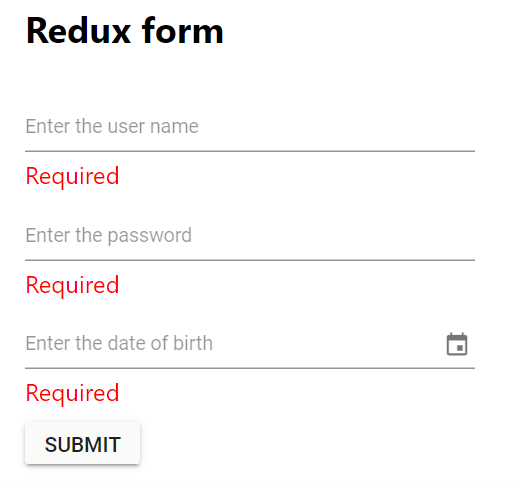Integration of Syncfusion® React Components in Redux Form
20 Aug 20259 minutes to read
Redux Form is a popular library used in React project for managing and handling form state. It integrates with the Redux state management library (Redux Store) and provides a simple and efficient way to handle form inputs, validation, submission, and data synchronization with Redux.
This guide will provide you with a step-by-step process for creating a Redux Form, integrating Syncfusion® components, and implementing form validation.
Create a Redux Form
To create a simple login form using React Redux Form, follow these steps:
1. Create a new React project.
2. Install the necessary Redux dependencies by executing the following command:
npm install --save redux react-redux redux-formIn this command:
-
Redux is a state container that stores the data.
-
React Redux allows users to read and update the data from the store to the React components.
-
Redux Form is used to manage the form state in React.
3. Create an empty form by creating a new file called LoginForm.js and defining the form component:
import { reduxForm } from "redux-form";
let LoginForm = (props) => {
return (
<form />
);
};4. Include the form component in your React project by adding the following code to the App.js file:
import './App.css';
import LoginForm from "./LoginForm";
function App() {
return (
<div className="App">
<div className="login-form">
<h2>Redux form</h2>
<LoginForm />
</div>
</div>
);
}
export default App;Setting up the Redux store
After creating the form and integrating it into the React project, set up a store in the index.js file to store the form state using the Provider component. This allows the Redux store to be accessible to the child components.
import { Provider } from 'react-redux';
import { createStore, combineReducers } from 'redux';
import { reducer as formReducer } from 'redux-form';
const appReducer = combineReducers({ form: formReducer });
const store = createStore(appReducer);
ReactDOM.render(<Provider store={store}><App /></Provider>, document.getElementById('root'));Connect with Redux Form
In the LoginForm.js file, connect the form component with Redux Form by exporting it using the reduxForm higher-order component:
export default LoginForm = reduxForm({
form: "login"
})(LoginForm);Add Syncfusion® React components
To incorporate Syncfusion® React components (DatePicker, TextBox, Button) into the login form, follow these steps:
1. Install the necessary dependencies for React components.
npm install @syncfusion/ej2-react-calendars @syncfusion/ej2-react-inputs @syncfusion/ej2-react-buttons --save2. Integrate the React components within the login form using the Field component provided by Redux Form.
import { reduxForm, Field } from "redux-form";
import { DatePickerComponent } from '@syncfusion/ej2-react-calendars';
import { TextBoxComponent } from "@syncfusion/ej2-react-inputs";
import { ButtonComponent } from "@syncfusion/ej2-react-buttons";
const textBox = ({ placeholder }) => {
return <TextBoxComponent placeholder={placeholder} floatLabelType="Auto" />
};
const datePicker = ({ placeholder }) => {
return <DatePickerComponent placeholder={placeholder} floatLabelType="Auto" />
};
let LoginForm = () => {
return (
<form>
<Field name="username" component={textBox} placeholder="Enter the user name" />
<Field name="password" component={textBox} placeholder="Enter the password" />
<Field name="dob" component={datePicker} placeholder="Enter the date of birth" />
<ButtonComponent type="submit">Submit</ButtonComponent>
</form>
);
};
export default LoginForm = reduxForm({
form: "login"
})(LoginForm);3. Define a handler function to handle form submission and display the form data in the App.js file:
function App() {
const handleLogin = values => {
console.log(`User name: ${values.username}`);
console.log(`Password: ${values.password}`);
console.log(`DOB: ${values.dob}`);
}
return (
<div className="App">
<div className="login-form">
<h2>Redux form</h2>
<LoginForm onSubmit={handleLogin} />
</div>
</div>
);
}
export default App;let LoginForm = (props) => {
const { handleSubmit } = props;
return (
<form onSubmit={handleSubmit}>
…
</form>
);
};Form Validation
Redux Form provides integrated support for validation. Define a validate function to check input values and display error messages if validation fails. Inputs are automatically validated on submission.
const validate = values => {
const errors = {};
if (!values.username) {
errors.username = 'Required';
}
if (!values.password) {
errors.password = 'Required';
}
if (!values.dob) {
errors.dob = 'Required';
}
return errors;
}
export default LoginForm = reduxForm({
form: "login",
validate
})(LoginForm);Displaying Errors
Upon form submission, the inputs will be validated and corresponding error messages will be displayed below the respective input fields.
const textBox = ({ placeholder, input, meta: { touched, error } }) => {
return <div>
<TextBoxComponent placeholder={placeholder} floatLabelType="Auto" {...input}
onChange={(e) => {
input.onChange(e.target.value);
}}
/>
{touched && error && <span className="error">{error}</span>}
</div>
};
const datePicker = ({ placeholder, input, meta: { touched, error } }) => {
return <div>
<DatePickerComponent placeholder={placeholder} floatLabelType="Auto" {...input}
onChange={(e) => {
input.onChange(e.target.value);
}}
/>
{touched && error && <span className="error">{error}</span>}</div>
};Run the project
To run the project, use the following command:
npm startRefer to the following output image.

Refer to the GitHub repository for a runnable demo.